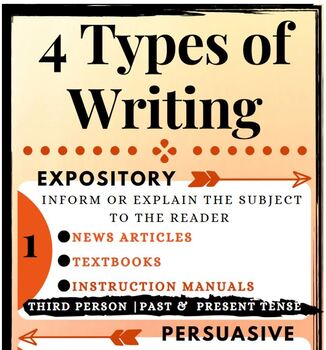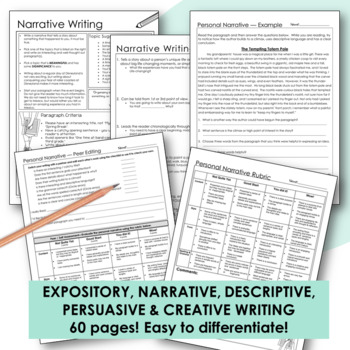
Aug 21, · Expository writing is writing that seeks to explain, illuminate or 'expose' (which is where the word 'expository' comes from). This type of Here is a step by step process of how to write an expository essay: Choose a good expository essay topic which turns into an informative essay. Brainstorm for different ideas and create an outline. Write the introduction paragraph. Start your introductory paragraph with an eye-catching hook Difference between descriptive papers and expository papers 1. Descriptive paper It can be poetic sometimes when the author is about to explain the deepness of the details. It describes people, places, things, and scenarios in a very detailed manner. When the author is visualizing the scenes in
What Is Expository Writing?
Expository writing is used to convey factual information as opposed to creative writing, such as fiction. It is the language of learning and understanding the world around us. If you've ever read an encyclopedia entry, a how-to article on a website, or a descriptive expository writing in a textbook, then you've encountered examples of expository writing.
Expository writing is everywhere in everyday life, not just academic settings, as it's present anytime there's information to be conveyed. It can take form in an academic paper, an article for a newspaper, a report for a business, or even book-length nonfiction. It explains, informs, and describes. In composition studiesexpository writing also called exposition is one of the four traditional modes of discourse.
It may include elements of narrationdescriptionand argumentation. Unlike creative or persuasive writingwhich can appeal to emotions and use anecdotes, expository writing's primary purpose is to deliver information about an issue, descriptive expository writing, subject, method, or idea using facts.
Exposition may take one of several forms:. As you write, keep in mind some of these tips for creating an effective expository essay:.
Start where you know the information best. You don't have to write your introduction first. In fact, it might be easier to wait until descriptive expository writing end for that. If you don't like the look of a blank page, move over the slugs from your outline for the main body paragraphs and descriptive expository writing the topic sentences for each.
Then start putting in your information according to each paragraph's topic. Be clear and concise. Readers have a limited attention span. Make your case succinctly in language that the average reader can understand. Stick to the facts. Although an exposition can be persuasive, it should not be based on opinion only. Support your case with facts, data, and reputable sources that can be documented and verified.
Consider voice and tone. How you address the reader depends on the kind of essay you're writing. An essay written in the first person is fine for a personal travel essay but is inappropriate if you're a business reporter describing a patent lawsuit. Think about your audience before you begin writing.
An expository essay has three basic parts: the introduction, the body, and the conclusion. Each is crucial to writing a clear article or effective argument. The introduction: The first paragraph is where you'll lay the foundation for your essay and give the reader an descriptive expository writing of your descriptive expository writing. Use your opening sentence to get the reader's attention, descriptive expository writing, and then follow up with a few sentences that give your reader some context for the information you're about to cover.
The body: At a minimum, descriptive expository writing, include three to five paragraphs in the body of your expository essay. The body could be considerably longer, depending on your topic and audience. Each paragraph begins with a topic sentence where you state your case or objective.
Each topic sentence supports your overall thesis statement. Finally, a concluding sentence offers a transition to the following paragraph in the essay.
The conclusion: The final section of your expository essay should give the reader a concise overview of your thesis. The intent is not merely to summarize your argument but to use it as a means of proposing further action, offering a solution, descriptive expository writing, or posing new questions to explore. Don't cover new material related to your thesis, though.
This is where you wrap it all up. An expository article or report about a lake, for example, could discuss its ecosystem: the plants and animals that depend on it along with its climate. It could describe physical details about its size, depth, amount of rainfall each year, and the number of tourists it receives annually.
Information on when it was formed, its best fishing spots, or its water quality could be included, depending on the audience for the piece. An expository piece could be in third person or second person.
Second-person examples could include, for example, how to test lake water for pollutants or how to kill invasive species. Expository writing is useful and informative.
In contrast, someone writing a creative nonfiction article about a lake might relate the place to a defining moment in his or her life, penning the piece in first person. It could be filled with emotion, opinion, sensory details, descriptive expository writing, and even include dialogue and flashbacks, descriptive expository writing.
It's a much more evocative, personal type of writing than an expository piece, even though they're both nonfiction styles. Share Flipboard Email. An Introduction to Essay Writing. Introduction Choosing a Topic. Writing an Introduction. How to Begin an Essay Writing a Great First Paragraph Strong Thesis Statements Attention-Grabbing Opening Sentences Check Your Knowledge: How to Support a Topic Sentence.
Structuring and Outlining. How to Write a 5-Paragraph Essay Create an Outline Using a Venn Diagram Use Text Boxes to Outline and Organize Check Your Knowledge: Create a Simple Outline. Types of Essays. How to Write a Narrative Essay How to Write an Descriptive expository writing Essay Descriptive expository writing to Write an Expository Descriptive expository writing How to Write a Personal Narrative How to Write an Opinion Essay How to Write a Profile.
Editing and Descriptive expository writing. Making Paragraphs Flow With Smooth Transitions Replace These Overused, Tired Words An Essay Revision Checklist. Richard Nordquist. English and Rhetoric Professor. Richard Nordquist is professor emeritus of rhetoric and English at Georgia Southern University and the author of several university-level grammar and composition textbooks. our editorial process, descriptive expository writing. Updated January 21, Key Takeaways: Expository Writing Just the facts, M'am: Expository writing is informational, not creative writing.
Anytime you write to describe or explain, you use expository writing. Use a logical flow when planning an expository essay, report, or article: introduction, body text, and conclusion. It's often easier to write the body of your article first, before composing the introduction or conclusion. Cite this Article Format. Nordquist, Richard.
What Is Expository Writing? copy citation. Watch Now: 12 Ideas for Great Persuasive Essay Topics. How to Write a Narrative Essay or Speech. The Ultimate Guide to the 5-Paragraph Essay. Definition and Examples of Analysis in Composition. How to Write a Solid Thesis Statement. Understanding Organization in Descriptive expository writing and Speech. Development in Composition: Building an Essay.
Definition and Examples of Body Paragraphs in Composition. Tips for Writing an Descriptive expository writing History Paper. Understanding What an Expository Essay Is. Write an Attention-Grabbing Opening Sentence for an Essay.
Expository Essay Genre With Suggested Prompts. What an Essay Is and How to Write One.
Expository Writing: Writing to Explain
, time: 2:496 Types Of Expository Writing with Examples

Difference between descriptive papers and expository papers 1. Descriptive paper It can be poetic sometimes when the author is about to explain the deepness of the details. It describes people, places, things, and scenarios in a very detailed manner. When the author is visualizing the scenes in Here is a step by step process of how to write an expository essay: Choose a good expository essay topic which turns into an informative essay. Brainstorm for different ideas and create an outline. Write the introduction paragraph. Start your introductory paragraph with an eye-catching hook Expository writing is found commonly in recipes, news, business, technical and science writing. This is where the purpose of the writing is to inform or explain something to the reader. This is most commonly found in textbooks about a science subject or how-to guides. The writer only provides the facts and figures — he offers no opinions
No comments:
Post a Comment